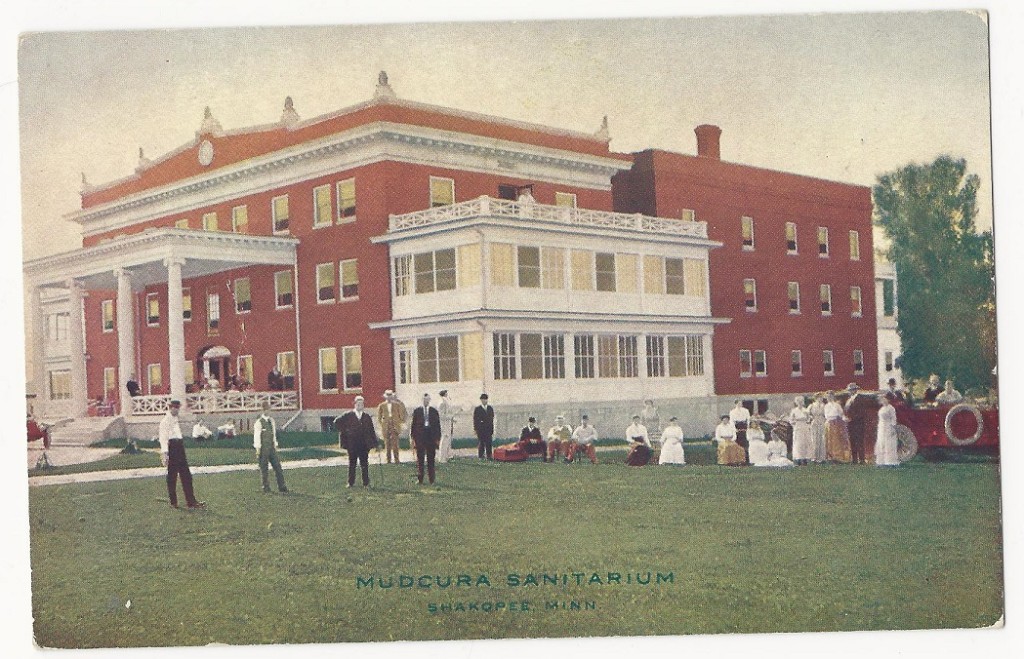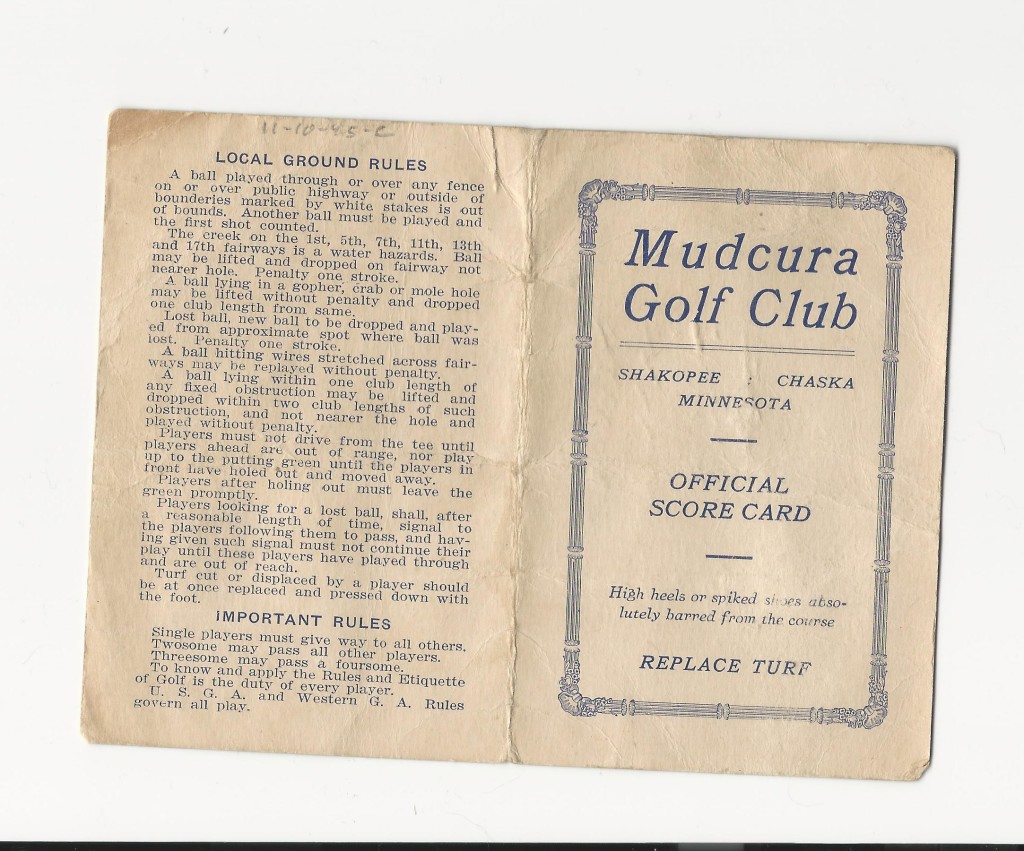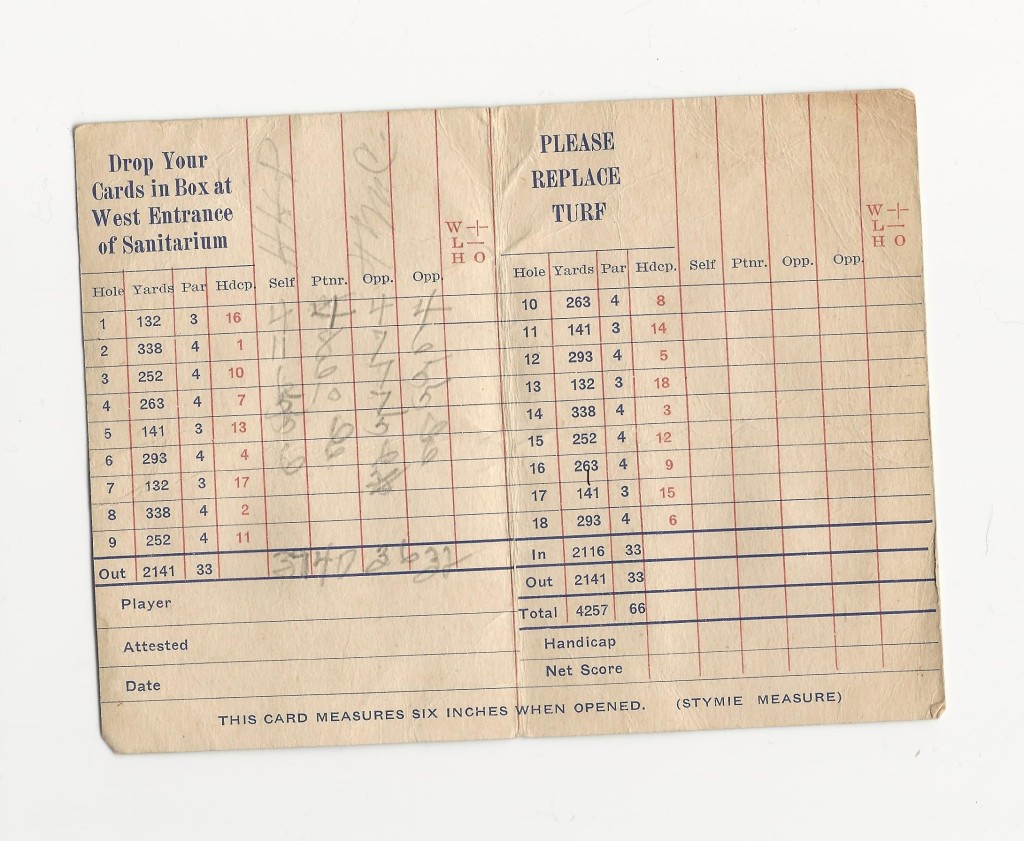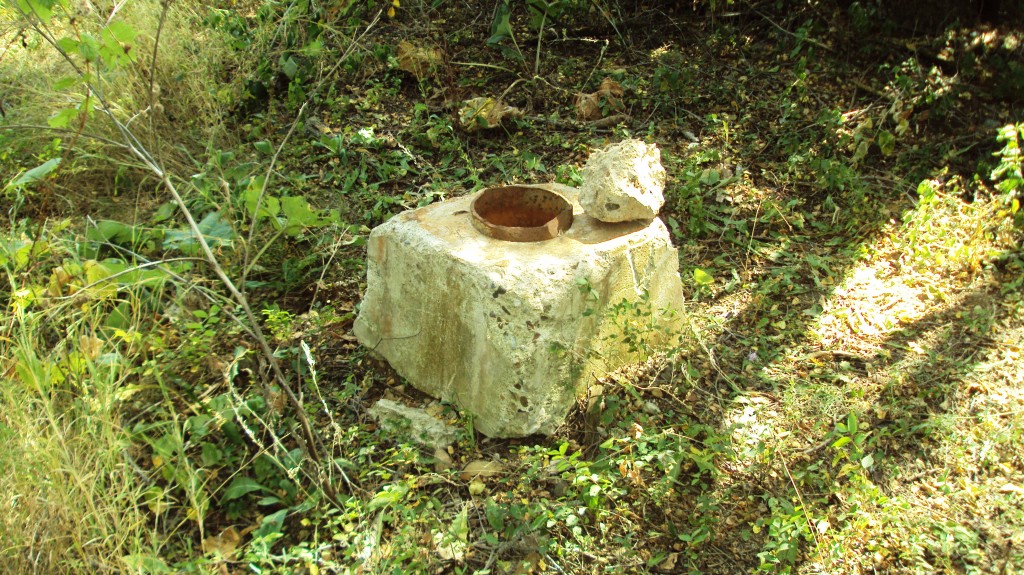Author’s note: When the 1,500 or so wingnut golf fans — and I use that term with all due respect — take their seats in the first-tee bleachers Friday through Sunday at the Ryder Cup at Hazeltine National, they will stare almost directly southwest as the players fire their opening salvos down the first fairway.
Were they able to peer an additional two miles down literally the same line — a line that goes from Hazeltine’s first tee box, through the greenside bunker to the right of No. 1 green and southwest almost to Flying Cloud Drive — they would be looking upon the site of what used to be another Carver County golf course. It is unidentifiable today and long since overgrown, but it’s there.
I wrote about the site in Chapter 20 of my 2014 book, “Fore! Gone. Minnesota’s Lost Golf Courses 1897-1999.” ($19.95, Five Star Publishing.) The chapter is repeated below, with the author’s permission (I asked. I promise.). The book is available on Amazon.com.
20. Not so much the golf course …
Mudcura Golf Club
City: Chanhassen
County: Carver
Years: 1926-1940s
The oddest confluence of modern-day Minnesota golf courses and their lost counterparts lies in and around the Carver County cities of Chaska and Chanhassen.
First, the former:
Three modern-day courses in this area boast indisputable stature: Chaska Town Course, designed by Arthur Hills, regarded by many as the best city-owned course in the state; Bearpath, just across the Carver County line in the Hennepin County city of Eden Prairie, designed by Jack Nicklaus and home to some of the state’s most affluent residents; and Hazeltine National in Chaska, designed by Robert Trent Jones and reworked by his son Rees, host club for two U.S. Opens, two PGA Championships and two U.S. Women’s Opens, and host-in-waiting for the 2016 Ryder Cup.
Now, the latter:
Wedged in among all that eminence are two old courses that are, frankly, about as revered as liver spots.
Tracy D. Swanson, president of the Chaska Historical Society, summarized two Carver County lost golf courses in an email:
“In the Chaska history book ‘Chaska, A Minnesota River City,’ golf was referred to by Chaskans as ‘cow pasture pool’ because a primitive course was carved out of a community pasture in Chaska in the 1930s.
“Another course just east of Chaska was located behind the old Mudcura Sanitarium, but the same soothing springs that gave cause for Mudcura’s existence also contributed to a poor golf course.”
Yikes. Don’t save a spot for these two in the pantheon of great layouts in Minnesota history.
Lost Course A — let’s call it Meadows Golf and Droppings Club — shall be allowed to fade into oblivion. As for Mudcura, there is further peculiarity — not from the golf course so much as from its next-door neighbor.
Mudcura Sanitarium was just north of what is now Flying Cloud Drive and west of Bluff Creek Drive, in southwestern Chanhassen. Its cause was noble. A Chaska Herald story reported that the sanitarium, which was said to have opened in 1909, “offered mud baths and respite for those suffering from rheumatism, arthritis, asthma and a variety of skin, kidney and nervous diseases.” It also was said to have been an early alcohol abuse treatment facility.
Even before the place opened, however, and certainly afterward, there was oddness.
A detailed history of Mudcura Sanitarium written by Joseph Huber, Michael Huber and Patricia Huber noted that the grounds were situated on 120 acres, half of them mud, that construction on the main building began in 1908, and that by December of that year, “with only the foundation completed, they were calling the facility the Swastika Sulphur Springs Sanitorium. … When finished it was called Mudcura, even though they still had a decorative Swastika in the main office.”
In fairness, it should be noted that the swastika symbol did not come to have negative connotations until it was adopted by the Nazi party in Germany in the 1920s and incorporated into the state flag of Germany after Adolf Hitler’s Nazi party gained power in 1933.
During the decades Mudcura Sanitarium operated, there was mud everywhere – and a few dark moments, according to the Hubers’ history. A man receiving treatments at Mudcura was nabbed after stealing a $600 diamond in 1921. A June 1925 tornado did $25,000 worth of damage to the property, and sanitarium founder Dr. Henry P. Fischer and his assistant Larry Hunter both received broken arms trying to close a second-floor door during the storm. Later that year, a patient’s body was found on the grounds; he had presumably slit his own throat with a pocketknife.
Mudcura was sold in 1951 to, according to the Hubers’ history, “the Black Franciscans, Order of Friars Minor Conventual, Our Lady of Consolation Provience, Louisville, Kentucky.” The place later became known as Assumption Seminary, a seminary college and dairy farm operating in association with the colleges of St. Catherine and St. Thomas from the 1950s to 1970.
After the seminary closed, the grounds lay dormant. The main building did not age gracefully, apparently becoming something of a haven for partiers and curiosity seekers, some with a bent for the paranormal.
And eventually, Mudcura Sanitarium was labeled these things:
— Creepy.
— Haunted.
— Hell House.
Yes, Hell House. That appellation was spray-painted on the front of the building, and there are reports of satanic graffiti having been applied liberally to other parts of the abandoned building. There are multiple reports of the building’s caretaker chasing interlopers off the property with a shotgun and one report of the caretaker painting over the satanic graffiti with biblical phrases.
“Just thinking about that place gives me the heebie jeebies up my back,” wrote one person on an Internet message board.
At least three websites feature prominent entries on what became the gloomier side of Mudcura. All can be easily accessed through a simple Internet search. Details will not be provided here, so as to spare the faint of heart from a possible case of the heebies, or jeebies, or both.
The Mudcura Sanitarium building burned to the ground in 1997 in a spectacular blaze. The Hubers’ history reported that the Chanhassen Fire Department burned the dormitory down as a practice exercise, but others have suspected a more nefarious cause: arson.
Two people who posted about Mudcura on Internet sites graciously offered more information on their visits to the Mudcura grounds vie email but declined requests to be interviewed on the record.
“When it burned down, I nearly cried. It was like I lost an old friend,” wrote one, a frequent Mudcura visitor.
“It was definitely creepy,” wrote the other.
And this: “My great-grandfather was one of the foremen during its last renovation before being abandoned. He kept extensive journals from his life, and included a strange comment about the building that said, ‘it will be too soon the next time I return to this place.’ Also he said many of the workers had very unusual experiences while working on the project. He didn’t note in any detail. … On the night the building burned down, one of my aunts committed herself into religious asylum for protection (which she never explained to anyone) and my other aunt decided to burn my great-grandfather’s journals.”
The burned-out building stood for a time before it was reduced to rubble, and the rubble was hauled away.
The first mention of Mudcura Golf Course in Carver County Historical Society archives is from an Aug. 19, 1926, story in the Weekly Valley Herald of Chaska. The newspaper reported on a match at the course between players from Shakopee and Chaska. Shakopee won the match, 727 strokes to 731. E.G. Darsow had the lowest 18-hole score, an 85. Six of the 17 competitors were doctors. All players had dinner at the sanitarium, and the club was offering memberships for the balance of the season for $5.00 for “Gentlemen” and $2.50 for “Ladies.”
A Weekly Herald story from April 19, 1928, reported on a meeting at which a membership limit of 85 had been established. “The club is composed of members from Chaska and Shakopee, who are very enthusiastic about their little course which is described by many golf fans as being one of the most sporty in this section.”
Scorecards courtesy of Phil Kostolnik
An old, undated scorecard says Mudcura was a par-33 course. The scorecard lists nine holes out and nine holes in, as would any traditional scorecard for a nine- or 18-hole course. But here’s where it gets curiouser and curiouser, as if so much about Mudcura weren’t curious enough:
All indications are that Mudcura was a six-hole course.
On the scorecard, the yardages for holes 1 through 6 are identical to those of holes 7 through 12, and then again for holes 13 through 18. The golfers who filled out the scorecard marked only the first six holes, a logical ending point on a six-hole course. What’s more, a 1937 aerial photograph of the area distinctly shows six — no more, no less — small, white circles, identical in appearance to sand greens seen on other aerial photos from the same era. The circles are distinct enough to suggest the course was still active.
The aerial photo contradicts the notion that the golf course was “behind” the sanitarium. Two greens were, but the rest of the course appears to be west of the sanitarium, on both sides of the creek, almost as far south as Flying Cloud Drive.
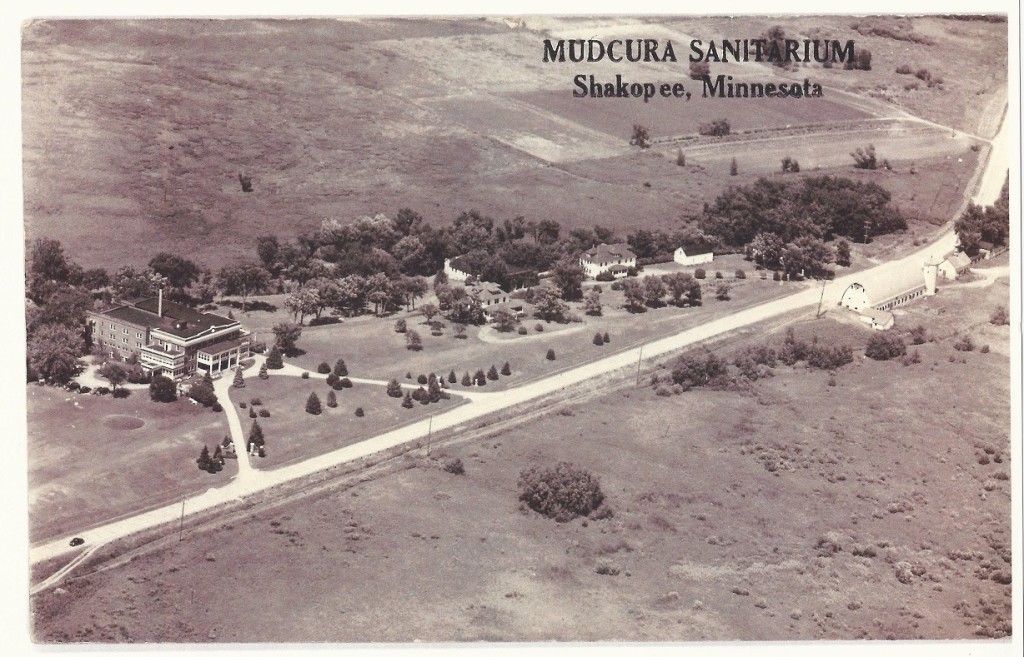
The creek came into play on two holes, according to the scorecard, and the second hole, a 338-yard par 4 and the No. 1 handicap hole, must have been a beast: Someone named “HHP” took an 11, with no scores higher than 6 on the rest of the card.
The scorecard included this notation: “Drop your cards in box at west entrance of sanitarium.”
The likely resting place of part of the former Mudcura Golf Club grounds can be viewed from the Minnesota River Bluffs LRT Regional Trail, by walking about a half-mile west on the trail where it intersects Bluff Creek Drive. The site is nothing more than farmland and marshland, with no evidence of golf ever having been played there. “If you like nature, it’s worth it just for the view,” one of the website posters wrote.
Beyond the newspaper stories and the scorecard, Mudcura Golf Club is barely a footnote in county history. On this author’s visit to the Chaska-Chanhassen area, six people were asked about it. Three had heard of the sanitarium, two others of the seminary. None had heard of the golf course.
Today, all that remains of Mudcura Sanitarium are portions of the driveway, angled and leading to a circular slab of concrete that served as a parking area, judging by old aerial photos. Just to the west, in a thicket, is another slab of old concrete, about a foot square and a foot high. And that is it.
The surrounding area, however, is not without modern-day significance. It is the site of Seminary Fen. A fen is a lowland, and Seminary Fen is a calcareous fen, considered one of the rarest ecosystems in the world. A 2008 Minneapolis Star Tribune story covering the dedication of Seminary Fen described this area of the Minnesota River Valley:
“Environmentalists say that only about 500 calcareous fens exist worldwide, with Minnesota home to about 200 of them. … The fens thrive in cold groundwater at the bottom of a slope or bluff enriched with calcium and magnesium.”
Limited public access is permitted on 73 acres of Seminary Fen, which is under the supervision of the Minnesota Department of Natural Resources.
You’re welcome to walk around in much of the fen. You might discover the scant remains of Mudcura Sanitarium. Maybe, if you’re paranormally plugged in, you’ll sense the old “Hell House” aura. But Mudcura Golf Club is history. Very little history, actually, but history nonetheless.
Nugget: Though the Mudcura grounds are closer to the downtowns of both Chaska and Shakopee, they are within the Chanhassen City limits. Two public courses are within 1 1/2 miles of Mudcura: Bluff Creek and Halla Greens.
